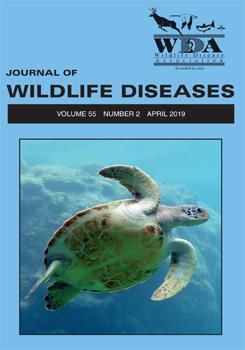Babesia odocoilei, a tick-borne protozoan hemoparasite of white-tailed deer (Odocoileus virginianus), is being increasingly recognized as a cause of disease in captive cervids in North America. Historically endemic in white-tailed deer, the natural wildlife reservoir in the southeastern US, B. odocoilei has been recently associated with hemolytic anemia in captive Eurasian tundra reindeer (Rangifer tarandus tarandus), wapiti (Cervus canadensis), and woodland caribou (Rangifer tarandus caribou) in the northcentral and northeastern US and several Canadian provinces. The emergence of B. odocoilei is likely related to the northward expansion of the range of the tick vector, Ixodes scapularis, and possibly to cervid translocations. Following a disease outbreak in reindeer and wapiti at the Toronto Zoo in Ontario, Canada, we utilized a prospective postmortem survey to investigate the prevalence of B. odocoilei in wild, farmed, and zoo cervids in Ontario (n=270) in 2016–18 by PCR and DNA sequencing of spleen samples. Zoo bovids have been suggested as potential hosts of B. odocoilei in zoos affected by cervid babesiosis, so we also collected postmortem samples from five species of bovids (n=7) at the Toronto Zoo that died or were euthanized during this time. We detected B. odocoilei in 1% (2/142) of farmed red deer (Cervus elaphus) as well as in 3% (1/29) of captive wapiti and 4% (3/68) of wild white-tailed deer. Tissues from all zoo bovids and caribou, zoo and wild moose (Alces alces), and farmed white-tailed deer, wapiti-red deer hybrids, and fallow deer (Dama dama), tested negative for B. odocoilei. No clinical cases of babesiosis were encountered during this study. These findings suggest that white-tailed deer are a potential natural wildlife reservoir for B. odocoilei in Ontario and that red deer and wapiti could serve as more-localized reservoirs.
How to translate text using browser tools
9 April 2019
MOLECULAR DETECTION OF BABESIA ODOCOILEI IN WILD, FARMED, AND ZOO CERVIDS IN ONTARIO, CANADA
Ellie L. Milnes,
Grace L. Thornton,
Pauline Delnatte,
Alexandre N. Léveillé,
John R. Barta,
Dale A. Smith,
Nicole M. Nemeth
ACCESS THE FULL ARTICLE

Journal of Wildlife Diseases
Vol. 55 • No. 2
April 2019
Vol. 55 • No. 2
April 2019
Babesia odocoilei
cervid babesiosis
Cervus canadensis
Cervus elaphus
Ixodes scapularis
Odocoileus virginianus
tick-borne disease




